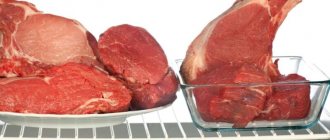The best way to identify stale or even spoiled pork is an unpleasant odor. However, if you buy meat in packaging, it is impossible to smell it. Sometimes we think we're buying fresh, chilled meat, but it's quite possible that the meat was frozen many months earlier in the store's own storeroom. Check the meat for any unpleasant odor. If the meat has a rotten smell, it has most likely gone bad. Spoiled red meat has a sharp, pungent “aroma.” Throw away meat if it smells bad, and especially if it is past its expiration date.
How to determine the freshness of turkey meat?
The carcass should be well-fed, meaty with a thick breast and legs. The skin should be light with a slightly yellowish tint, moist, without blemishes. A simple procedure will help you determine the freshness of a turkey: press your finger on the carcass, and if the hole from your finger immediately recovers, it means the meat is fresh.
Interesting materials:
How often do you change tires on an airplane? How often do you change filter cartridges? How often should you change table tennis rubbers? How often should you change the strings on a tennis racket? How often can you use a coffee body scrub? How often can you use the Skatka facial scrub? How often can you dye your hair with henna? How often can you water flowers with aspirin? How often can you use an eyelash curler? How often can you take drotaverine?
Signs of spoiled meat
The shelf life of red meat is about 2-4 days, white meat - no more than 5 days if it is raw. Look for the production date on the packaging. It should be indicated if you bought meat in a store. If the date is not indicated or you threw away the packaging, look for the main signs of spoiled meat:
- Unpleasant smell.
When meat spoils, it becomes rotten, pungent and even caustic. To smell the scent, do not bring the product to your nose. Take our experts' advice: simply place your palm on the meat and then bring it to your face. It's much safer and more convenient.
- The appearance of mucus
. This happens if storage conditions were violated (for example, the product was not stored in the refrigerator). The surface of the meat becomes sticky and covered with a gray coating.
- Color.
The meat should have a uniform color (pink, white). Darkening or the appearance of a so-called “tan” indicates spoilage of the product. When pressed with a finger, the meat fibers should return to their original shape in 5-10 seconds.
Beef smells - what to do
Normally, beef smells slightly of musk and fresh blood - you can eat such meat. If there is a smell of rot or decomposition, as well as any other foreign or unnatural odors, you should under no circumstances eat meat.
Read: Chocolate without palm oil: is there such a thing in Russia?
The answer to why beef smells can have various reasons. In general, beef meat loses its natural (normal) flavor under the following conditions:
- Storing in a cellophane or other bag - then the meat simply “suffocated”;
- The meat was next to a strong-smelling product;
- The animal was fed an inappropriate coma;
- The conditions or procedure for slaughter have been violated.
If the beef smells unpleasant, but is otherwise not spoiled, you can try rinsing it in cold water and cooking it. You also need to treat the piece with a salt solution with spices (cloves, basil, pepper) or lemon juice. It is useful to soak such beef in a solution of potassium permanganate, or in vinegar. But it’s better not to - such meat must be taken to the store or market where it was purchased. If there isn't one, just throw it away. Yes, it's expensive. But next time you will choose your meat more carefully.
Why is meat sour?
Among the most common, it is worth highlighting the following: the animal was killed incorrectly; the animal was treated with antibiotics and did not meet the required deadlines before slaughter; the piece of meat was stored incorrectly and bacteria began to multiply in it.
Interesting materials:
How to remove acrylic paint from glass? How to remove ink from wallpaper? How to remove ink from fabric? How to remove glue from fingers? How to remove paint from wood? How to remove marker from a whiteboard? How to remove marker from hair? How to remove whitewash from linoleum? How to remove 3m tape from plastic? How to remove 3m tape?
Basic indicators
Before you start cooking any meat, you need to be sure that it is fresh enough and suitable for further processing. It is better not to use suspicious products. This may lead to undesirable consequences. In such cases, novice housewives ask the same question: how can you tell if the meat has gone bad? Experienced professionals or those who often encounter a similar problem can answer it. In their opinion, there are three main indicators of meat freshness:
- Appearance. The meat of any animal should have a color from bright pink to dark brown. Any rainbow tints and grayish shades are unacceptable. If a piece of meat has bones or joints, they should be white. For fatty layers, a yellowish tint is acceptable.
- Smell. When buying a product in a store, you must smell it. But how can you tell if the meat has gone bad? Usually an external examination is not enough. Here we must remember that fresh meat has virtually no odor except for a slight hint of milk. Any extraneous “aromas” indicate poor quality of the product.
- Consistency. How can you tell if meat has gone bad? Fresh meat should be elastic and quite dense to the touch. The dimple, which forms when light pressure is applied by hand, usually disappears immediately. A spoiled product, on the contrary, will be loose. The finger enters it like butter. In addition, a fresh piece of meat will never be sticky or slippery.
Knowing these indicators, it is easy to distinguish a good product from a bad and low-quality one.
Determining the freshness of pork
Each type of meat has its own characteristics. For example, there is pork on the counter in a store. How can you tell if meat has gone bad? Here again we need to remember three main features.
The color of a piece of pork must be soft pink. A darker shade indicates that it is either no longer fresh, or the meat of an old animal is in front of you. In this case, it is better to refuse such a purchase. A dish prepared from such pork will taste disgusting and will not bring pleasure. If the meat is very pale, then growth hormones may have been added to the animal feed. It is not safe to cook food from such products. If the meat looks normal outwardly, this does not mean that it does not need to be smelled. Sometimes sellers try to hide the unpleasant odor with spices or table vinegar. The presence of any foreign aromas indicates that the product is not as good as it seems. When pressed with your finger, pork, like any other meat, should be elastic. When buying a product on the market, you must not forget to check for the presence of a sanitary inspection stamp.
Is the minced meat spoiled?
Inexperienced housewives are often lost when it comes to minced meat. How can you tell if meat has gone bad if what you see is not a whole piece, but a chopped semi-finished product? However, the freshness of minced meat is determined by the same indicators.
The product must be carefully inspected, smelled and definitely touched with your hands. Only then can a final decision be made regarding its suitability. Take, for example, minced beef. It doesn't have to be cherry red. During storage, beef gradually begins to darken from the inside. This is caused by the lack of direct access to oxygen. In the middle, over time, the minced meat may even turn brown. But that's quite normal. The semi-finished product should not smell bad. This is a clear sign of a spoiled product. Here we must always remember that even fresh products contain bacteria. Therefore, if there is any suspicious aroma, it is better not to take risks. In conclusion, you should definitely touch the minced meat with your hands. If it is sticky, slippery or too wet, then no amount of heat treatment will correct such a product.
What to do if the meat has gone bad?
- Slime. If there is a small amount of mucus on the pulp, rinse the product thoroughly under cool water. Try to remove the sticky film under pressure. Leave the piece of meat in cool water for 15-20 minutes. If there are no other signs of spoilage, then the product can be used.
- Rotting. Has the meat started to rot? Eating it is dangerous! Don’t skimp on your health and the health of your loved ones – it’s best to throw away the meat. Giving it to pets (cats, dogs) is also strongly discouraged.
- Darkening of meat, “tanning”. Chop the product into separate pieces, dry well with paper towels and test in the open air. Severely darkened or discolored areas should be carefully cut out and discarded. Rinse the remaining meat with water and 1-2 tablespoons of salt. If there are no other signs of spoilage, then the product can be used.
- Unpleasant smell. The easiest way to remove odor is to soak the product in a vinegar solution (1 tablespoon vinegar per 1 liter of water) or saline solution (2 tablespoons salt per 1 liter of water). The recommended holding time is about 1-2 hours.
Beef and pork can be marinated in a wine solution with spices. Rosemary and thyme will do.
Chicken, duck or goose can be doused with a weak solution of potassium permanganate and then kept in cool water for about 1 hour.
Rabbit, goat meat, horse meat can be poured with warm chamomile decoction. Recommended holding time is 20-25 minutes.
Other products you can use to eliminate odors:
- mustard,
- salt and sugar,
- rosemary,
- thyme,
- mixture of herbs,
- special seasonings (for example, for barbecue),
- soy sauce,
- onion,
- garlic.
Simply prepare marinades using them, leaving the meat to marinate for 1-2 hours.
How to cook spoiled meat?
If you have used our life hacks and have already been able to get rid of the unpleasant odor or sticky film, then start cooking.
We recommend boiling chicken, duck and goose. The minimum heat treatment time when signs of product spoilage appear is 1 hour. The longer the better.
We recommend stewing beef, pork and other red meats. Only long cooking methods will do. For example, beef goulash, which needs to be simmered over low heat for about 2.5-3 hours.
Please note that you cannot cook meat whose signs of spoilage have not been eliminated!
Damaged packaging
If, after taking the meat out of the freezer, you notice that the package is torn, this poses several risks:
- Firstly, the meat could get an icy “burn”. In these places the color of the product will change to a lighter color. It is better to cut off damaged areas, as they will spoil the overall impression of the dish.
- Secondly, the meat could absorb the unpleasant smell of the freezer.
- Thirdly, damaged packaging can cause product damage. Of course, this is not so critical for a home freezer, but you shouldn’t buy something like this in a store.
How to remove during cooking?
To minimize the unpleasant odor that may appear during cooking, the meat must be pre-soaked. Vegetables baked in a dry frying pan will help solve the problem. They, like spices, can be added to the broth after boiling.
Bay leaf flavors the broth well . But you don’t need a lot of it - just one is enough for a three-liter pan.
You should also collect the foam that appears in a timely manner. If the smell is strong, drain the first broth after boiling, add fresh water and continue cooking.
How and why beef smells
Fresh raw beef has a weak and specific smell, boiled beef has a stronger smell and this aroma is most often very pleasant. It is more problematic to describe what fried beef smells like, since with this type of processing the natural odor is partially masked by aromatic seasonings. The same goes for ground beef with additives.
The older the animal, the more pronounced the smell. Another important point is that the meat of uncastrated males smells stronger than the meat of females. The meat of cattle, which is fed mostly with feed containing large amounts of protein, smells stronger. The use of certain veterinary drugs shortly before slaughter can also affect the smell of meat and fat.
Beef often develops odor during storage. When stored for a long time, beef may smell differently. The most common scenarios are:
- Slight damp smell - often found after defrosting;
- Rancid odor - This odor indicates oxidation of fat. You cannot eat such meat, even after heat treatment;
- Sour, unpleasant odor - meat is damaged by microorganisms. You cannot eat such meat, even after heat treatment.
- Old dry meat has its own aroma, which is difficult to confuse with something else. But frozen meat, normally, has no odor.
How to check if meat has spoiled?
There are several life hacks on how to check if meat has spoiled. The easiest way is to heat a knife (for example, put it in boiling water or hold it over a fire), and then cut the piece of meat down to the bone. It starts to deteriorate in the middle, i.e. just near the bone and you can see if rotting has begun.
Other ways to check if meat has gone bad:
- Place the meat in boiling water.
3-5 minutes will be enough to find out whether it is missing or not. A spoiled product will smell unpleasant (sour, putrid odor). There is an opinion that spoiled pulp leads to cloudiness of the broth, but this is just a myth.
- Take a paper towel (sheet of paper),
wrap the meat in it. Leave the pulp as is if you suspect that you have been sold spoiled and synthetically colored meat at the market or in a store. Any dyes will appear on paper within 3-5 minutes.
Determining freshness by meat type
The meat of different animals has its own characteristics. If for pork only pink color is the norm, then for chicken even a small amount of grayish color is acceptable. When preparing meat for further processing, areas with this color simply need to be cut off.
We recommend: I stock up on grape leaves for the winter for dolma: I tell you what I do with them
Pork
Color will help you recognize if a piece of meat is stale. Fresh product obtained from a young animal should be pale pink. Darker shades indicate its windiness. If the tenderloin is obtained after the slaughter of an old pig, then the dish for which the product is purchased will be spoiled. Old pork has a bad taste.
It happens that the meat, on the contrary, is very light. This may indicate the addition of growth hormones to animal feed. It is not safe to eat this kind of cut.
If a piece looks great on the outside, you need to smell and touch it. Sometimes meat sprinkled with spices ends up on the shelves. You should refuse such a purchase: unscrupulous sellers can hide the unpleasant aroma that appears.
Chicken
If stored for a long time and improperly, the chicken carcass, as well as its individual parts, may become unusable. In spoiled fillets, the pink color changes and becomes gray. If there are few such areas, you can save the meat by cutting them down to healthy tissue and lightly boiling the remaining piece.
Spoiling chicken has a characteristic unpleasant odor that cannot be masked.
Another parameter indicating the poor quality of the product, or rather its unsuitability, is sticky and slippery skin. A slight coating forms on the surface in the form of a thin shiny film. If cooked chicken has been in the refrigerator for a long time, you can also determine by its condition whether it is suitable for consumption. The smell of sulfur and the appearance of a greenish color are a signal that it is time to throw away the product.
Beef
Since beef is a perishable product, it is important to correctly determine the condition of the meat. There are three main parameters to determine. But if doubts remain, you can take into account auxiliary signs.
Determining the freshness of beef meat
| Parameter | Description |
| Smell | The word “neutral” best describes the aroma of beef. If it is sour, sweet or unpleasant, you should not buy such a cut. |
| Appearance | Not knowing what quality beef tenderloin looks like can be a reason to buy a second-fresh product. Good meat should be deep red. If there are crusts and dark spots on the piece, it has been stored for too long. |
| Consistency | A quality product is smooth, dry, shiny and elastic. When pressed, the meat quickly restores its original shape. |
| Other | Fresh product should have light fat without shades of grey. Tubular bones are filled densely with bone marrow. Tendons are elastic. |
We recommend: How to make clear ice without bubbles at home?
Lack of markings
If you are not used to freezing a lot of food, the issue of labeling is irrelevant for you. But if you keep a large stockpile of meat, fish and vegetables in your freezer, be sure to label it with the name of the product and the date it was packaged. Otherwise, you will not know what and how much is stored. Accordingly, you will not be able to navigate expiration dates.
While home freezers tend to be relatively tidy, supermarkets and markets can be completely chaotic. Never buy frozen meat without a label on the package or if it is hard to read.
Found a violation? Report content
How long does pork last in the refrigerator?
Cold food storage scheme
| Food | Type | Refrigerator (40°F or below) |
| Hamburgers, minced meat and minced poultry | Hamburger, ground beef, turkey, chicken, other poultry, veal, pork, lamb and mixtures thereof | 1 in 2 days |
| Fresh beef, veal, lamb and pork | steaks | 3 in 5 days |
| Chops | 3 in 5 days | |
| Roast | 3 in 5 days |










